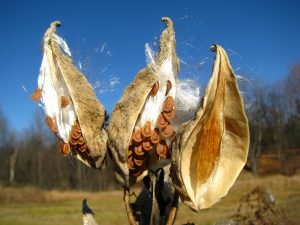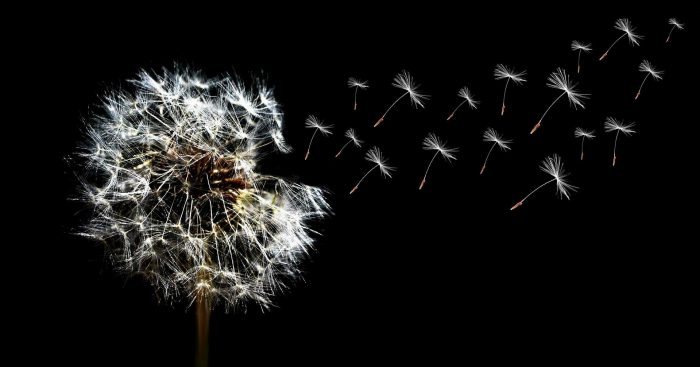Nature Matters: Seeds
By John L. Turner
Here’s a question for you to ponder: How, if you’re a stationary plant, can you be successful in having your seeds dispersed so that your progeny (new plants) can grow and prosper, thereby passing your genes on to the next generation?
If you look around your neighborhood answers abound and one of them found its way into my mouth recently in the form of a handful of black cherries. Black cherry is a common tree native to Long Island, scattered about in richer woodlands. Each summer, from late July through mid-August, these cherries produce copious amounts of fruit which are tasty — mind you, not as tasty or meaty as cultivated supermarket cherries — but still pretty good. I ate the pulp of each and one by one spit out the hard pits (and I’m proud to say a few went more than 10 feet!).

Cherries illustrate one of the primary means by which plants disperse their seeds: through ingestion by mobile animals. These animals, birds and mammals mostly, digest the pulp of the fruit but poop out the unaffected pit or seed, often many miles from the parent (with the poop providing a little bit of fertilizer to give the seed a head start). Many other plants, basically any fruit producing species such as tupelos, mulberries, raspberries and blueberries, depend upon animals for dispersal through ingestion.
For nuts and seeds its a bit more complicated. In this case, say with acorns or hickory nuts, but unlike fruits, if the nut is eaten then no new tree will grow. But even a squirrel or blue jay with a good memory is bound to forget the cached location of a few acorns it has stored, or perhaps was killed by a predator. In this case the movement of the nut by the animal is beneficial — just so long as it is not consumed.
Wind is a less visible but no less important dispersal agent. Many plants have evolved elaborate structures that aid in carrying seeds aloft to land well away from the parent plant. The native milkweeds are one example. Each seed is attached to silken hairs that form a structure similar to a parachute. Once the pod dries and splits open the seeds can be easily carried aloft by a strong breeze.
Another, perhaps even more well-known example involves dandelions, the circular seed head of which every child has blown on to scatter the silken seeds hither and yon. Each seed has a structure known as a pappus made up with one hundred or so hairlike bristles that carry the seed aloft, allowing it in steady winds to travel miles. Physicists have recently learned that air blowing upward through the pappus creates an area of low pressure above the seed which facilitates upward movement, allowing it to potentially travel great distances.
An alternate design that eases dispersal by the wind is found in maple seeds; they have winged membranes. This creates resistance to the air enabling the seeds to twirl away, some distance from the shade of the parent tree.

The most remarkable dispersal strategy involves propulsion and we have an excellent example on Long Island — jewelweed, also known as touch-me-not. Jewelweed is a common wildflower here, growing in moist to wet environments such as along streams and pond edges; locally it grows on the western side of the pond at Frank Melville Memorial Park in Setauket and is abundant in the southwestern corner of the pond. The orange flowers are quite distinguishable and noticeable. Hanging on slender stalks, they have a unique, bell-shaped outline with a curled spur in the back (giving rise to another colloquial name — ladies earrings). It is a favorite among pollinating insects and ruby-throated hummingbirds.
But what is really remarkable about the plant are its exploding seed pods which are elongated and five sided. As they mature the pods develop tension and if one ignores the admonition to “touch-it-not” and touches a pod it abruptly ruptures along the five sutures, with the seeds propelled outward several feet; the result is an exploded-looking seed pod with the sides curled outward.
The other name — jewelweed — comes from one of two explanations. Rain and dew bead up on the leaf surface and in the sunlight the water drops sparkle like jewels. The other has to do with the jewel-like shimmer of the leaf’s underside when submerged in water. The shimmer is caused by minute pockets of air caught in the hairs on the undersurface and gives rise to yet another name — silverleaf.
With regard to aquatic plants it is not surprising they often depend upon water for dispersal of seeds. Coconuts are perhaps the best example and they display a common and unsurprising trait of water dispersed seeds — they float. Closer to home we have several species of woody plants and wildflowers whose seeds float on the water, including birch and willow trees, and pondside flowers like irises.
Another novel strategy plants employ to spread seeds involves those which get entangled in the fur of mammals and feathers of birds. A few local examples include tick trefoil, cocklebur, beggar’s ticks, and common burdock.
Tick-trefoil, of which there are a few species, produce pods, not surprising since they are members of the Pea family. The pods are covered with many tiny hair-like hooks enabling the pod to easily dislodge and attach to an animal’s fur — or your pants leg! I’ve occasionally come back from a hike with several dozen pods clinging resolutely to pant legs, socks, and shoes.
The seeds of beggar’s ticks act similarly although in their case the seed has two “horns,” each equipped with tiny barbs that serve as fasteners. In the case of cockleburr and burdock, the plants produce oval burrs, their surfaces chock-filled with hooks. An animal brushes against the plant and the easily dislodged burrs go for a ride.
It was such a ride on an animal, George de Mestral’s dog Milka to be precise, that led to the invention of a product that is ubiquitous today — Velcro. Back in 1941, after a walk with his Irish pointer, de Mestral took a closer look under a microscope at the burdock burrs stuck to his pet’s fur. He was intrigued by the many hooklike structures and began to experiment. Fourteen years later he patented Velcro, so named from two French words: “velour” meaning velvet-like (one surface of Velcro) and “crochet” meaning hook (the other surface); together they mean “hooked velvet.”
You can see common burdock, the inspiration for Velcro, along nature trails throughout Long Island and perhaps burdock burrs will find their way onto your shoes and clothing equipped with that modern invention — Velcro — they served to inspire.
A resident of Setauket, John Turner is conservation chair of the Four Harbors Audubon Society, author of “Exploring the Other Island: A Seasonal Nature Guide to Long Island” and president of Alula Birding & Natural History Tours.







